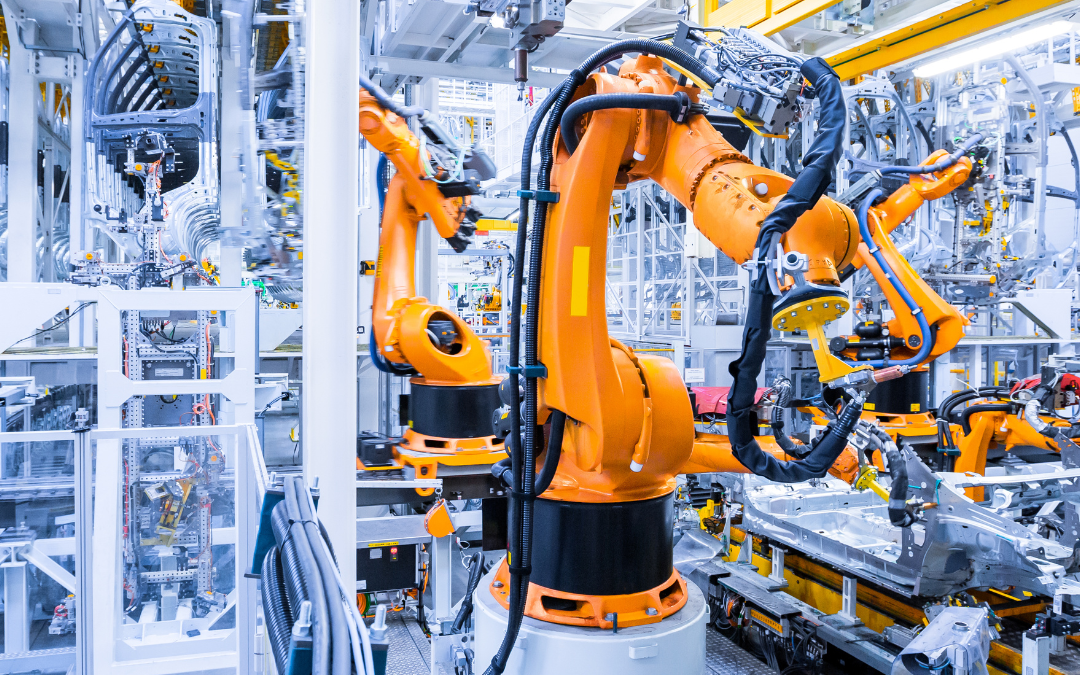In manufacturing, AI brings revolutionary solutions that redefine efficiency, sustainability, and competitiveness, promising unparalleled potential for businesses ready to embrace the (positive) change it brings!
Manufacturing struggles to keep up in today’s market due to increasing demand for customization, shorter product lifecycles, and the need for sustainable practices amidst evolving consumer preferences and global competition.
AI streamlines those challenges in manufacturing by optimizing production processes, predicting maintenance needs, and enabling data-driven decision-making, ultimately enhancing efficiency, agility, and sustainability in the industry.

Keep reading to learn:
- AI in manufacturing: How is it used?
- Examples of AI in manufacturing
- How is AI helping to achieve sustainable development goals?
- How does AI help to reduce carbon footprint for manufacturing companies?
- Funding your choice for AI-driven sustainability
AI in manufacturing: how is it used?
The manufacturing industry involves the production of goods through various processes, from raw material conversion to assembly, to meet consumer demand for a wide range of products.
The manufacturing industry uses AI to enhance efficiency and productivity by automating tasks, optimizing processes, improving quality control, and enabling predictive maintenance and supply chain management.
Leveraging AI for sustainable manufacturing
In the quest for sustainability, manufacturing businesses are turning to innovative technologies, such as AI, to reduce their carbon footprint and promote environmental stewardship.
By using AI-driven solutions, companies can optimize their operations, minimize waste, and enhance resource efficiency, contributing to a greener and more sustainable future.
- Predictive maintenance: AI-enabled predictive maintenance systems analyze equipment data in real-time, allowing businesses to identify potential issues before they occur and proactively address them. By minimizing equipment downtime and preventing unnecessary repairs, companies can reduce energy consumption and extend the lifespan of their machinery, leading to significant cost savings and environmental benefits.
- Quality control: AI-powered computer vision systems revolutionize quality control processes by detecting defects and anomalies in products with unparalleled accuracy and efficiency. By ensuring that only high-quality products reach the market, manufacturers can minimize waste and reduce the environmental impact associated with defective production.
- Supply chain optimization: AI algorithms optimize supply chain management by analyzing vast amounts of data, including inventory levels, demand forecasts, and transportation routes. By streamlining logistics and minimizing excess inventory, businesses can reduce emissions associated with transportation and storage, contributing to a more sustainable and efficient supply chain.
- Robotics and automation: AI-driven robotics and automation technologies automate repetitive tasks, such as assembly and material handling, with precision and efficiency. By replacing manual labor with AI-powered robots, companies can improve workplace safety, reduce energy consumption, and minimize waste generation, leading to a more sustainable manufacturing process.
- Process optimization: AI analytics tools analyze production data to identify inefficiencies and optimize manufacturing processes for maximum efficiency and resource utilization. By fine-tuning operations and minimizing energy and material waste, businesses can reduce their environmental footprint while improving productivity and profitability.
AI plays a pivotal role in driving sustainable manufacturing practices by providing innovative solutions that optimize operations, enhance efficiency, and minimize environmental impact.
As manufacturing businesses seek funding for the adoption of sustainable technologies, AI stands out as a key enabler of green innovation, offering practical solutions that align with the goals of environmental sustainability and economic prosperity.
Examples of AI in manufacturing
The food industry
AI benefits the food industry by improving quality control, optimizing supply chains, and enhancing food safety. Machine learning algorithms analyze data from production lines to detect defects and ensure consistent product quality.
AI-driven predictive analytics optimize inventory management and reduce waste by accurately forecasting demand. Additionally, AI-powered systems monitor and manage food safety by detecting contamination risks and ensuring compliance with health regulations.
Clothing & consumer goods
In the clothing and consumer goods sector, AI enhances design, production, and inventory management. AI-driven design tools help create fashion trends and optimize product development cycles.
Automated quality control systems inspect garments for defects, ensuring high standards. Machine learning algorithms predict consumer preferences and optimize inventory levels, reducing overproduction and minimizing waste. AI also personalizes the shopping experience, offering tailored recommendations to consumers.
Industrial & housing supply industry
The industrial and housing supply sector leverages AI to optimize production processes, improve supply chain management, and enhance product quality. AI-powered predictive maintenance systems reduce equipment downtime and extend the lifespan of machinery.
Advanced data analytics optimize material usage and minimize waste during production. AI algorithms improve supply chain efficiency by forecasting demand and optimizing inventory management, ensuring timely delivery of construction materials.
Printing
AI transforms the printing industry by streamlining production workflows, enhancing print quality, and reducing operational costs. AI-driven predictive maintenance systems monitor and maintain printing equipment, minimizing downtime. Machine learning algorithms analyze print quality in real-time, detecting and correcting defects to ensure consistent output.
Additionally, AI optimizes ink usage and energy consumption, making the printing process more efficient and environmentally friendly.
Chemicals
In the chemicals industry, AI enhances process optimization, safety, and sustainability. AI-driven predictive analytics optimize chemical production processes by monitoring and adjusting variables in real-time. Machine learning models predict equipment failures and schedule maintenance to prevent costly downtime.
AI also improves safety by analyzing data from sensors to detect hazardous conditions and prevent accidents. Furthermore, AI helps develop eco-friendly chemical formulations, reducing the environmental impact of chemical production.
Pharmaceuticals
The pharmaceuticals industry uses AI to accelerate drug discovery, optimize manufacturing processes, and ensure quality control. AI-driven algorithms analyze vast datasets to identify potential drug candidates and predict their effectiveness.
Machine learning models optimize production processes, ensuring consistency and reducing production costs. AI-powered quality control systems monitor and inspect pharmaceutical products, ensuring they meet stringent regulatory standards. Additionally, AI enhances supply chain management, ensuring the timely delivery of critical medications.
Electronics
AI benefits the electronics industry by improving design, production, and quality control processes. AI-driven design tools optimize circuit layouts and component placement, enhancing product performance. Machine learning algorithms monitor production lines, detecting defects and ensuring consistent quality.
Predictive maintenance systems reduce equipment downtime and extend the lifespan of manufacturing machinery. Additionally, AI optimizes supply chain management, forecasting demand and managing inventory to reduce waste and improve efficiency.
How is AI helping to achieve sustainable development goals?
AI is playing a pivotal role in helping manufacturing businesses achieve sustainable development goals by revolutionizing processes, optimizing resource utilization, and promoting eco-friendly practices.
Through advanced data analytics, machine learning algorithms, and predictive modeling, AI enables companies to identify inefficiencies, optimize energy consumption, and minimize waste generation throughout the production cycle.
By harnessing the power of AI-driven automation and optimization, manufacturers can streamline operations, reduce environmental impact, and contribute to a more sustainable future.

How does AI help to reduce carbon footprint for manufacturing companies?
AI offers manufacturing companies a range of innovative solutions to reduce their carbon footprint and promote environmental sustainability. One key area where AI excels is in optimizing energy efficiency.
By analyzing real-time data from sensors and IoT devices, AI algorithms can identify energy-intensive processes and suggest optimization strategies to minimize energy consumption.
Additionally, AI-powered predictive maintenance systems help companies proactively identify equipment failures and optimize maintenance schedules, reducing downtime and energy waste.
Another way AI reduces carbon footprint is through supply chain optimization. By leveraging AI-driven supply chain analytics, manufacturers can optimize transportation routes, minimize inventory levels, and reduce emissions associated with transportation and logistics.
AI also enables companies to make data-driven decisions in material sourcing, selecting suppliers with environmentally friendly practices and reducing the environmental impact of raw material extraction and production.
How does AI support sustainable technology in Canada?
In Canada, Sustainable Development Technology Canada (SDTC) plays a crucial role in supporting the development and adoption of sustainable technologies, including AI.
SDTC provides funding and support to Canadian businesses and innovators working on projects that promote environmental sustainability and address climate change challenges.
With a focus on clean technology innovation, SDTC collaborates with industry partners, government agencies, and research institutions to accelerate the deployment of AI-driven solutions that reduce carbon emissions, improve energy efficiency, and advance sustainable development goals across various sectors, including manufacturing.
Related: Did you know that we help our clients find AND apply for funding opportunities? If funding opportunities through SDTC sound like a fit for your business, reach out to us today and we can help you through the application process by taking it off your plate.
Building AI Plan: Getting Started
At New Motto, we believe Canadian businesses are ready to start thinking bigger, producing more, and growing to their full potential. Developing a winning AI Plan and implementing an AI Strategy is one of our highest priorities for clients today.
So, we are offing a FREE AI Planning Session, to help businesses learn and explore how AI can work best for them.
It is 30-minutes, on Zoom, and is available to businesses all across Canada. There is no pressure to work with New Motto following your session and you’ll walk away with ideas you can use today!
Put our team to work for you. Together, we’ll make sure your business has every skill and tool you need to grow.

